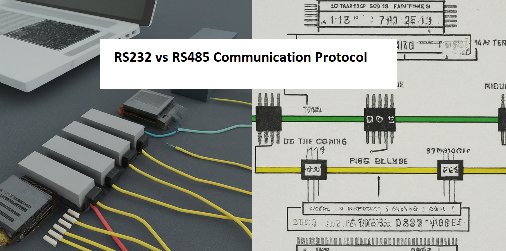Difference between RS 232 & RS 485 Communication Protocol – When it comes to serial communication, RS-232 and RS-485 are two widely used standards. While they share the same basic principles, they differ significantly in terms of distance, speed, and noise immunity.
RS-232
- Distance: Suitable for short distances, typically up to 15 meters (50 feet).
- Speed: Lower transmission speeds, typically up to 20 kilobaud.
- Noise Immunity: Susceptible to noise interference, especially in electrically noisy environments.
- Number of Devices: Can connect a limited number of devices (usually two).
- Typical Applications: Connecting a computer to a modem, printer, or other peripheral devices.
RS-485
- Distance: Capable of transmitting data over longer distances, up to 1200 meters (3900 feet).
- Speed: Higher transmission speeds, typically up to 10 megabaud.
- Noise Immunity: More resistant to noise interference, making it suitable for industrial environments.
- Number of Devices: Can connect up to 32 devices on a single bus.
- Typical Applications: Industrial automation, building automation, and data acquisition systems.
Key Differences
| Feature | RS-232 | RS-485 |
|---|---|---|
| Distance | Short (up to 15 meters) | Long (up to 1200 meters) |
| Speed | Low (up to 20 kilobaud) | High (up to 10 megabaud) |
| Noise Immunity | Low | High |
| Number of Devices | Limited (usually two) | Up to 32 |
| Typical Applications | Consumer electronics | Industrial automation |
Choosing the Right Protocol
The choice between RS-232 and RS-485 depends on the specific requirements of your application. If you need to connect devices over short distances and do not require high speeds or noise immunity, RS-232 may be sufficient. However, for longer distances, higher speeds, and noisy environments, RS-485 is a more suitable option.
In conclusion, both RS-232 and RS-485 are valuable tools for serial communication. By understanding their key differences, you can select the appropriate protocol to meet the needs of your application.
Home | Join us on Facebook, Twitter, YouTube, Instagram, Quora, Reddit, LinkedIn, Pintereset, Blogger.
